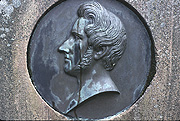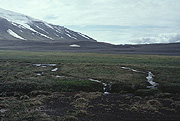| Date: | 1845. |
| Form: | Three stanzas, each containing four three-stress lines, with the rhyme scheme AbCb and the alliteration pattern 22. |
| Manuscript: | KG 31 a II, where it has no title (facsimile KJH286; image). |
| First published: | 1847 (A241-2; image) under the title "Tómasarhagi" ("Tómas's Meadow"). |
| Sound recording: | Emily Auerbach reads "Tómas's Meadow."  [0:32] [0:32] |
Numerous obstacles present themselves to any person who may think of entering this dreadful country, among which the want of food for horses is the principal. The rivers, lakes, streams of lava, all the horrors of nature combined, oppose every desire to penetrate into these unknown districts; and the superstitious dread in which they are held by the natives is readily excused, the instant they are even remotely beheld. (
TII244)
In June/July 1835 Jónas's friend Tómas Sæmundsson set out from Breiðabólsstaður, in the south of Iceland, to cross this forbidding terrain and collect his new wife and her belongings in the north (at Garður in Aðalreykjadalur). A month later, on 6 August, Tómas's former mentor and close friend Bishop Steingrímur Jónsson wrote Jón Sigurðsson in Copenhagen:
This past July Rev. Tómas Sæmundsson travelled north across Sprengisandur with some of his farmhands. He was completely unfamiliar with the route and got into serious trouble because of the lack of pasturage, but chanced upon a valley, thickly covered with grass, that was situated directly on — or very near — the track. Afterward he was so sure of the way that he returned to Breiðabólsstaður by the same route with his pregnant wife and her belongings.
2
The importance of this circumstantial and strictly contemporary account of Tómas's adventure — which is likely to have been communicated directly to the Bishop by Tómas himself — will appear in a moment. It is a pity that Tómas never completed and published in Fjölnir the article he mentioned in a letter to Jónas on 6 September: "an account of a journey across Sprengisandur which might advance people's knowledge of that least-known part of Iceland" (BTS161).
We may speculate that when Tómas described the newly discovered meadow to friends like Bishop Steingrímur and Jónas Hallgrímsson,3 he emphasized its lushness (which is why Steingrímur refers to it as "a valley, thickly covered with grass" [grasi vaxinn, loðinn dal] and Jónas thought of it as standing "completely green in the desert sands" [algrænn á eyðisöndum]). Tómas probably gave the geographer Björn Gunnlaugsson, his (and Jónas's) old Bessastaðir teacher, the same sort of description, and this may explain why Björn, after visiting the meadow himself in the summer of 1841 in the course of a surveying expedition, chose to downplay its extent and importance:
Beneath Tonguehill Glacier, halfway along the side facing Eagle Mountain Glacier, is a round hill, the highest in the vicinity. It stands right next to the glacier, separated from it by a narrow gap. Beneath this hill, on the side opposite the glacier, are some gravel flats and in the midst of them is Tómas's Meadow, a field of grass hardly big enough to support a single cow. (
3LÍ315)
Still, because of its potential importance for travellers, the name and location of Tómas's Meadow were included on Björn's map of Iceland (1848), the first reliable map of the entire country (and the map to which Jónas's "Description of Iceland" was intended to be complementary).4
Among Tómas's descendants, in later years, the story of his adventures in the summer of 1835 seems to have become confused and even (to some extent) exaggerated. His grandson Bishop Jón Helgason, who published (in 1941) what is still the standard biography of Tómas, thought that his difficulties with pasturage for the horses and his discovery of the meadow had occurred when he was travelling south, returning to Breiðabólsstaður with his wife and her belongings.5
But when they reached a point some 40 kilometers south of the last farms in Bárðardalur, they ran into a blinding blizzard, and before Tómas was fully aware of what was happening he had lost all sense of direction. He kept going, however, and it was not long before his horses suddenly — and of their own accord — started to crop grass here and there. They had found a meadow beneath the snow, though Tómas had never known that one existed here in the eastern part of the desert. It is not unlikely that this discovery saved his life, since he was not prepared for an extended stay in the highlands, accompanied by so many horses. Now he could pitch his tent, free from anxiety about the horses, and wait until the storm had passed. The next morning the weather was so clear that they could see the mountains and it was a simple matter to ascertain the right direction and continue the journey without hazard. The meadow he had discovered lay up under Tonguehill Glacier and has been known ever since as
Tómas's Meadow.
6 (
TSÆ114)
All of this would hardly be worth discussing at such length were it not for two considerations, the first of which is decidedly the more important (and more substantial).
(1) Jónas's last two lines, literally translated, read: "my mind [or 'imagination'] carries me half the way; it [i.e., the terrain] slopes downward to the north." Since these lines clearly reflect the point of view of someone, travelling north, who has reached the highest point along the route (i.e., the approximate site of Tómas's Meadow) and is starting down toward the sea, Jónas must have had in mind the same version of events as Bishop Steingrímur. If a reader does not realize this, he will find the topographical reference at the end of the poem puzzling and even incoherent (which is not something to be expected from this poet, of all poets).
(2) Readers who import into the poem too many dramatic touches (terrific blizzards, horses pawing up the snow to find the grass beneath it) may miss some of the quieter and deeper notes of this poignant and ironic elegy: Tómas has reached the high point of his journey across Iceland, his newly-found meadow — lush and green — has solved the problem of food for the horses, and he is starting down toward a joyous reunion with the woman he loves. What a fine moment! But alas, Tómas had been dead four years when the poem was written, and the whole scene is nothing but an enactment of memory, imagination, and grief. (The ending of "Tómas's Meadow" is very rich and suggestive, and the intention here is not to exhaust its meaning but to suggest certain directions in which that meaning may most profitably be sought.)
Notes
1 The name actually means something like "the (vast) tract of sand that causes horses to die of exhaustion (að springa)"; see KMÍ124. "Deadhorse Desert" would thus be a more accurate translation, though far less pleasing aesthetically.
2 Gömul Reykjavíkurbréf 1835-1899, Finnur Sigmundsson bjó til prentunar, Íslenzk sendibréf IV (Reykjavík: Bókafellsútgáfan, 1965), p. 10.
3 The latter had ample opportunity to hear about it when he visited Tómas at Breiðabólsstaður for three weeks in the summer of 1837.
4 When Björn's map was being prepared for publication in Copenhagen by his Danish associate, the cartographer Oluf Nikolai Olsen (1794-1848), Jónas supplied the latter with a good deal of topographical information. "Among other things, Jónas provided a description of the lay of the land in the highlands up from Vestur-Skaftafellssýsla" (3LÍ327n2). Since this is roughly the area in which Tómas's Meadow is located, it seems possible that having his attention drawn to it during the map-making process was responsible for quickening in Jónas the memories that led to the composition of the poem. Jónas himself never travelled the Sprengisandur track or saw Tómas's Meadow.
5 The idea that Tómas's adventure occurred when he was travelling south first appears in Hannes Hafstein's 1883 note to the poem (B396) and is repeated in C, D, and E. That his wife was with him on the journey is first explicitly stated in 1904 by Þorvaldur Thoroddsen (4LÍ52) and is implicit in the account of these events three years later (1907) by Tómas's grandson Jón Helgason, in his edition of Tómas's letters (BTS142n1); it is subsequently repeated in D and E.
It is interesting to note that Þorvaldur Thoroddsen, who in 1904 wrote that Tómas's adventure had occurred "in the spring of 1835" when he was travelling "south across Sprengisandur with his wife" (4LÍ52), had — in 1885 — presented a quite different scenario: "Once when Rev. Tómas Sæmundsson was travelling north he strayed from the Sprengisandur track and discovered Tómas's Meadow" ("Ódáðahraun: Frásaga um ferðir og rannsóknir sumarið 1884," Andvari, 11 [1885], 31).
6 Tómas's daughter Þórhildur (1835-1923) was born 28 September 1835, so his wife Sigríður (1803-1878) was six or seven months pregnant in June/July when Tómas took her across Sprengisandur. Jón Helgason (1866-1948) must have learned the sensationalized version of his grandfather's adventure from these two women. But when the actual events occurred his mother (Þórhildur) had not yet been born and his grandmother (Sigríður) had not been present.

